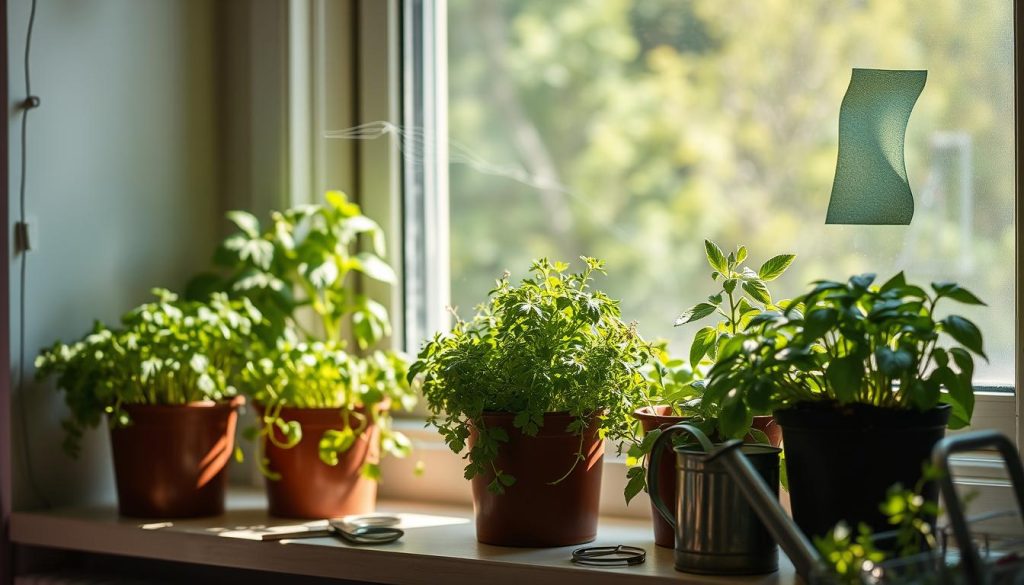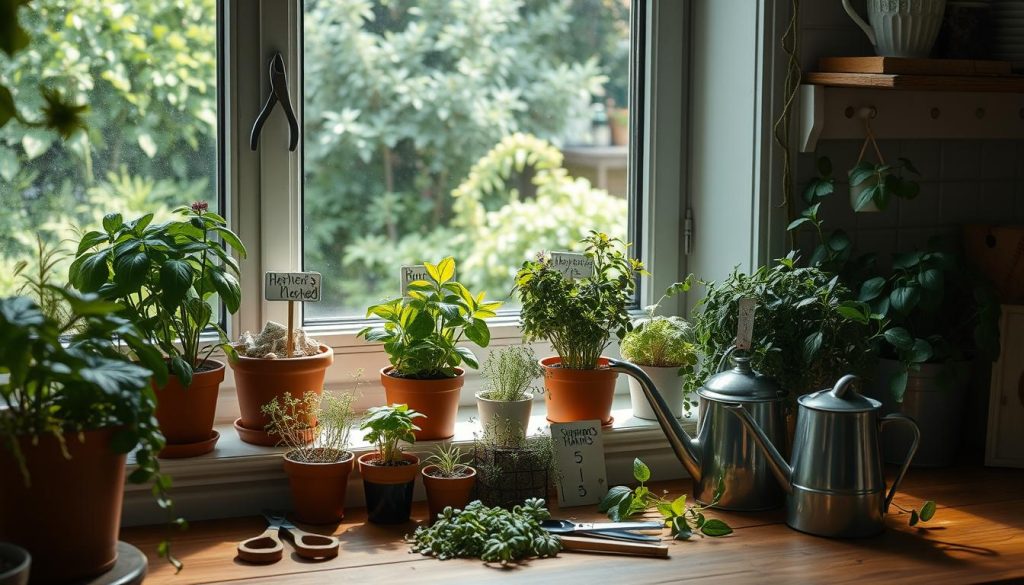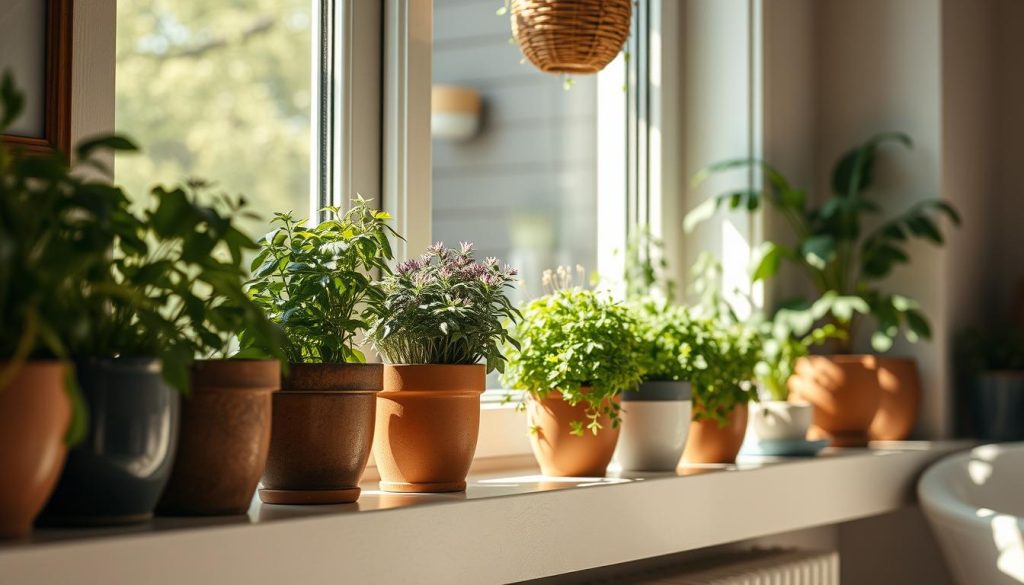Learning to grow herbs indoors is fun and rewarding. With the right tips, you can enjoy fresh herbs all year. Growing herbs indoors offers many benefits, like having fresh ingredients and enjoying gardening all year.
To start, you need to know the basics of indoor herb gardening. This includes choosing the right herbs, preparing the soil, and caring for them. In this guide, I’ll share my experience and knowledge. We’ll cover everything from setting up to harvesting and preserving your herbs.
Why I Love Growing Herbs Indoors
Growing herbs indoors has changed my life. It gives me fresh ingredients whenever I need them. With a bit of practice and patience, anyone can grow great herbs indoors.
One big benefit is having fresh herbs all year. This lets me try new recipes and flavors. To start, you need the right tools like a good pot, a sunny spot, and a watering can.

- Fresh ingredients at my fingertips, allowing me to add flavor and fragrance to my cooking
- The joy of gardening year-round, without being limited by the weather outside
- The satisfaction of watching my herbs grow and thrive, with proper indoor herb care
Growing herbs indoors has brought me joy and fulfillment. I highly recommend it for anyone wanting to improve their cooking.
Choosing the Right Herbs for Indoor Growth
Choosing the right herbs for indoor growth is key to a successful garden. Beginners should start with easy-to-grow herbs that need little care. Basil, mint, and cilantro are great for indoor gardens.
Popular Herbs for Beginners
These herbs are perfect for beginners. They are easy to care for and grow well indoors. Here are some popular herbs for beginners:
- Basil: a classic herb used in many Italian and Thai dishes
- Mint: a hardy herb that can be used in teas, cocktails, and desserts
- Cilantro: a fast-growing herb commonly used in Mexican and Asian cuisine
Flavorful Options for the Advanced Gardener
For more experienced gardeners, there are many flavorful options. Rosemary, thyme, and oregano can add depth to dishes. They are great for indoor gardens and provide fresh flavors all year.

| Herb | Lighting Requirements | Temperature Range |
|---|---|---|
| Basil | Bright, indirect light | 65-75°F (18-24°C) |
| Mint | Partial shade to full sun | 65-75°F (18-24°C) |
| Cilantro | Bright, indirect light | 65-75°F (18-24°C) |
Essential Supplies for Indoor Herb Gardening
To start an indoor herb garden, you need the right supplies. This includes containers, soil, fertilizers, and grow lights. The right supplies help your herbs grow well and keep your garden thriving.
Containers and Pots
Choosing the right containers and pots is important. Look for pots that are 6-8 inches deep to give roots room. Consider the material, like ceramic, plastic, or terracotta. Here are some tips:
- Choose a pot that is well-draining to prevent waterlogged soil
- Select a pot that is large enough to hold the mature size of your herb plant
- Consider using a self-watering pot to reduce maintenance
Soil and Fertilizers
Soil and fertilizers are key for indoor herb gardening. Pick a high-quality potting soil made for indoor plants. Use fertilizers to give your herbs the nutrients they need. Here are some tips:
| Soil Type | Fertilizer Type | Benefits |
|---|---|---|
| Organic Potting Soil | Balanced Fertilizer | Promotes healthy root growth and leaf development |
| Indoor Plant Soil | High-Phosphorus Fertilizer | Encourages blooming and fruiting |

Grow Lights: Do I Need Them?
Grow lights are helpful, especially without a sunny windowsill. They provide the light needed for photosynthesis. With the right supplies, you can have a thriving indoor herb garden all year.
Finding the Perfect Location in My Home
When growing herbs indoors, finding the right spot is key. The perfect location means fresh flavors and a bit of green in your home. Start by thinking about sunlight. Most herbs love lots of sunlight, so a sunny windowsill or grow lights are great.
Temperature is also important. Herbs do best in daytime temperatures of 65-75°F (18-24°C) and cooler nights around 55-65°F (13-18°C). Keep them away from heating vents, fireplaces, and drafty windows. The right spot helps your herbs thrive and brings you the joys of indoor gardening.

- East- or west-facing windows are ideal for herbs that require partial shade.
- South-facing windows are best for herbs that need full sun.
- Avoid placing herbs in areas with extreme temperatures or humidity.
Follow these tips and think about your herbs’ needs. You’ll find the perfect spot in your home. Then, you can enjoy the many perks of growing herbs indoors.
How to Plant Herbs Indoors
Planting herbs indoors is easy with some basic knowledge. Choosing the right containers and soil is key. Growing herbs indoors can be rewarding, giving you fresh herbs all year.
Container gardening is a good start. It lets you control soil, light, and water. Pick a container that’s 6-8 inches deep with drainage holes. Use a well-draining potting mix and plant your herbs at the same depth as in their pots.
Step-by-Step Planting Process
- Choose the right container and soil for your herbs
- Plant your herbs at the same depth as they were in their nursery pots
- Water your herbs thoroughly after planting
Watering Tips
Watering is crucial for indoor herbs. Water when the top inch of soil feels dry. Avoid too much water to prevent root rot. Here’s an image to show why proper watering is important:
By following these steps, you can have a thriving indoor herb garden. It will give you fresh herbs all year. Whether you’re growing culinary herbs or starting with container gardening, keep your herbs happy and healthy.
Caring for My Indoor Herb Garden
To keep my indoor herb garden healthy, I follow a few key steps. I prune, fertilize, and repot as needed. These steps help my herbs grow well.
It’s important to watch the temperature and humidity levels. I also make sure they get enough light. And I water them carefully to avoid overwatering, which can harm them.
Regular Maintenance Routines
Here are some tips for indoor herb gardening:
- Prune herbs regularly to keep them bushy and prevent them from getting too long
- Fertilize herbs monthly with a balanced fertilizer to give them the nutrients they need
- Repot herbs every 6-12 months to refresh the soil and give them more room if they need it
Common Pests and How to Handle Them
Even with good care, indoor herb gardens can get pests. Spider mites, mealybugs, and aphids are common ones. To deal with these, I use organic pest control like neem oil or insecticidal soap.
I also make sure to keep infected plants separate. This helps stop the pests from spreading to other plants.
Watering My Herbs: Finding the Balance
Watering is key when growing herbs indoors. It’s all about finding the right amount of water. Too little or too much can harm your plants. Knowing the signs of overwatering and underwatering is crucial.
Signs of overwatering include yellow leaves and soft stems. Underwatering makes herbs wilt and become brittle. To avoid these issues, create a watering schedule that fits your herbs’ needs.
Here are some tips for watering your herbs correctly:
- Water your herbs in the morning, so they can absorb water all day.
- Check soil moisture by sticking your finger into the soil up to the first knuckle.
- Water when the top inch of soil feels dry to the touch.
By following these tips, you can keep your indoor herb garden healthy. This way, you’ll have fresh herbs all year. Remember, the key to indoor herb care is finding the right balance. With practice, you’ll master growing herbs indoors.
Feeding My Herbs for Optimal Growth
As I care for my indoor herb garden, I’ve learned how vital feeding is. It’s key to know which fertilizers to use and when. This ensures my herbs get the nutrients they need to grow well.
I have many choices for fertilizers, like organic and synthetic ones. Organic options include compost tea, fish emulsion, and worm casting. They’re good for my herbs and the planet. Synthetic fertilizers give a quick nutrient boost but can harm the environment and health if misused.
Types of Fertilizers to Use
- Compost tea: a natural, organic fertilizer made by steeping compost in water
- Fish emulsion: a liquid fertilizer made from fish waste and plant matter
- Worm casting: a natural, organic fertilizer made from worm waste
- Synthetic fertilizers: quick-acting fertilizers made from chemical compounds
To keep my herbs healthy, I feed them regularly. How often depends on the fertilizer and the herb’s growth stage. I feed them once a week when they’re growing and once every two weeks when they’re dormant. This helps my indoor herb garden thrive.
Harvesting Herbs: The Right Way
As I near the end of my journey on how to grow herbs indoors, I’m excited to share with you the rewarding process of harvesting your homegrown herbs. Timing is everything in indoor herb care. Harvesting at the right time ensures maximum flavor and aroma, making all your efforts in growing culinary herbs indoors worthwhile.
Timing for Maximum Flavor
To get the most out of your herbs, consider harvesting them in the morning. This is when the oils in the leaves are most concentrated, giving you the best flavor. For leafy herbs like basil and mint, pinch off individual leaves as needed, or cut off stems just above a node to encourage new growth.
Best Practices for Harvesting
When harvesting, use scissors or pinch off leaves and stems with your fingers to avoid bruising the plants. Regular harvesting will also help keep your plants bushy and prevent them from flowering. By following these simple tips on how to grow herbs indoors and practicing good indoor herb care, you’ll be enjoying fresh, fragrant herbs from your indoor garden in no time.
Remember, the key to successful harvesting is to be gentle with your plants and to harvest them regularly. With a little practice, you’ll become an expert in growing and harvesting your own indoor herbs. You’ll enjoy the many benefits of indoor herb care and growing culinary herbs indoors.
Preserving My Homegrown Herbs
As I tend to my indoor herb garden, I’ve learned the value of keeping my herbs fresh all year. With the right tips, my herbs stay flavorful, even when they’re not in season. Preserving them is key, and I’ve found several effective ways to do so.
Preserving herbs is crucial, and I focus on the essentials for my indoor garden. Drying and freezing are top methods. For drying, I can air dry, oven dry, or use a dehydrator. Each method has its own perks. Air drying is easy and cheap, while dehydrating keeps the herbs’ taste and smell intact.
Drying Methods
- Air drying: This method involves tying the herbs in small bunches and hanging them upside down in a warm, dry place.
- Oven drying: This method involves placing the herbs on a baking sheet and drying them in a low-temperature oven.
- Dehydrating: This method involves using a dehydrator to dry the herbs, which helps preserve their flavor and aroma.
Freezing Tips
Freezing is another excellent way to keep my herbs fresh, especially for basil and mint. I chop them finely and store them in airtight containers or freezer bags. This way, I can use them in soups, sauces, and more.
By using these tips and the right care, I can enjoy my herbs all year. Whether I dry or freeze them, I ensure their taste and aroma last. This lets me add freshness and flavor to many dishes.
Troubleshooting Common Indoor Herb Issues
Growing culinary herbs indoors can be rewarding but comes with challenges. Identifying and solving common problems is key to healthy plants. With the right tips, indoor herb gardening can thrive.
Yellow leaves and stunted growth are common issues. These can stem from nutrient deficiencies, pests, or environmental factors. I’ve found a few strategies to tackle these problems effectively.
Yellow Leaves: What It Means
Yellow leaves often indicate overwatering or underwatering. Regular soil moisture checks help prevent this. I also ensure my herbs get the right light and nutrients.
Stunted Growth Solutions
For healthy growth, I provide the right nutrients and prune regularly. Repotting in fresh soil and giving herbs space also helps. These tips have helped me overcome common issues and enjoy a thriving garden.
By addressing common indoor herb issues, I’ve improved my care and harvested plenty of fresh herbs. Whether indoors or outdoors, staying vigilant and solving problems ensures the best results.
Sharing My Herb Garden With Others
As my indoor herb garden grows, I love sharing it with family and friends. I make thoughtful gifts like herb-infused olive oils and herb-themed decorations. Hosting a herb tasting dinner is also a great way to share my passion and inspire others.
Family and Friends Gift Ideas
My friends and family love gifts from my indoor herb garden. Whether it’s homemade pesto, dried herbs, or a potted plant, they appreciate the personal touch. These gifts not only delight the senses but also highlight the benefits of indoor herb gardening.
Hosting a Herb Tasting Dinner
Hosting a herb-inspired tasting menu is a great way to share my love for indoor herb gardening. I plan menus that feature the fresh flavors of my herbs. It’s rewarding to see others enjoy the flavors and learn about indoor herb gardening.

